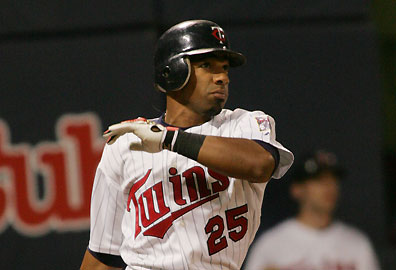September 9, 2008
Twins Notes: Average, Average, and Schedules
There's certainly nothing wrong with hitting .293/.337/.398, especially for a 23-year-old middle infielder, but the lesson with Casilla is that people like me place a ton of emphasis on players' minor-league track records for a reason. Casilla got off to a great start that involved hitting for a higher batting average and more power than he looked capable of sustaining based on his minor-league numbers and sure enough he came back down to earth a bit once the sample size of plate appearances increased.
 MLB second basemen as a whole have hit .275/.336/.408 this year, so continuing to bat .293/.337/.398 (or .285/.340/.400) would essentially make Casilla average offensively for his position. Defensively he's posted an .800 Revised Zone Rating in 673 innings at second base, which is three percent worse than the AL average of .820 and ranks just 11th among the league's 14 second basemen who've logged at least 500 innings. On the bases he's been surprisingly passive, going just 6-for-8 on steals.
MLB second basemen as a whole have hit .275/.336/.408 this year, so continuing to bat .293/.337/.398 (or .285/.340/.400) would essentially make Casilla average offensively for his position. Defensively he's posted an .800 Revised Zone Rating in 673 innings at second base, which is three percent worse than the AL average of .820 and ranks just 11th among the league's 14 second basemen who've logged at least 500 innings. On the bases he's been surprisingly passive, going just 6-for-8 on steals.
Add it all up and Casilla has been slightly below average for the position as a 23-year-old in his first full season, which is very encouraging from someone who was hitting just .219 at Triple-A when the Twins called him up in mid-May. While his lack of power perhaps makes it tough to project the same type of long-term improvement that you'd assume from most league-average 23-year-olds, Casilla's showing in 79 games with the Twins should make the team feel good about second base going forward.
SHORTSTOP RZR SECOND BASE RZR THIRD BASE RZR
Nick Punto .831 Nick Punto .778 Nick Punto .705
MLB Average .833 MLB Average .820 MLB Average .698
Unfortunately he hasn't been average since taking over at shortstop after Casilla's return, with so-so range, several game-changing errors, and a .245/.316/.286 line in 13 consecutive starts at the position. He's bounced back offensively after a historically awful 2007, matching Casilla by hitting .285/.342/.397. That'd be very good production from a truly great defender, but that label is more perception than reality with Punto. Still, like Casilla he's been a pleasant surprise and more or less average overall this year.
Whether based on his track record in the minors, relatively brief time in the majors, or raw stuff there's little to suggest that Bass is capable of being more than a marginal big-league pitcher. I've harped on that point all year while perhaps being overly harsh on Bass, but the Twins' decision to keep him on the roster for fear of losing him on waivers quickly went from odd to inexplicable. After predictably passing through waivers unclaimed, Bass has been traded to the Orioles for a player to be named later.
LaVelle E. Neal III of the Minneapolis Star Tribune reports that Bass may "go into Baltimore’s rotation to audition for next year," but his first Orioles appearance came as a reliever. More specifically, he entered a 2-2 game with the bases loaded in the sixth inning, promptly walked in the go-ahead run, and then allowed two runs of his own on the way to an 11-2 loss. If Bass somehow ends up in a major-league rotation for any length of time, the over-under on his ERA should probably be around 5.50.
Twins: White Sox:
3 vs Royals 4 vs Blue Jays
3 at Orioles 3 vs Tigers
3 at Indians 4 at Yankees
4 at Rays 3 at Royals
3 vs White Sox 3 at Twins
3 vs Royals 3 vs Indians
The Twins' remaining opponents have a .499 winning percentage, whereas the White Sox's remaining opponents have a .505 winning percentage. That may look significant because one set of opponents is above .500 and the other is below .500, but in reality the difference between .499 and .505 is just one win over the course of a 162-game schedule. In other words, the two schedules are basically even and both teams have 10 games left on the road.
If you ignore the matching opponents and the three-game series against each other at the Metrodome during the final week of the season, the schedules essentially boil down to this: The Twins play three games against the Royals, three games against the Orioles, and four games against the Rays, while the White Sox play three games against the Tigers, four games against the Blue Jays, and four games against the Yankees.
Viewed that way the Twins' opponent's winning percentage is .503, compared to .520 for the White Sox, which equals a three-game difference over a full season. Time is definitely running out, but the Twins will be in reasonable shape as long as they're within two games when the White Sox come to town on September 23. Winning two of three would then put them a game back going into the Royals series, at which point they'd need to win at least two out of three while rooting for the Indians to do the same.
Once you're done here, check out my latest "Daily Dose" column over at Rotoworld.

